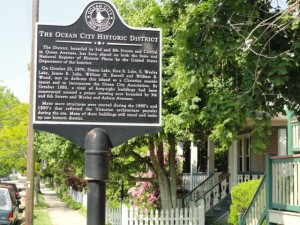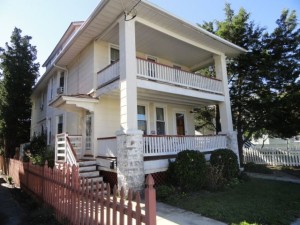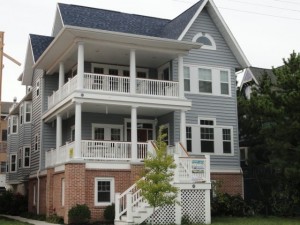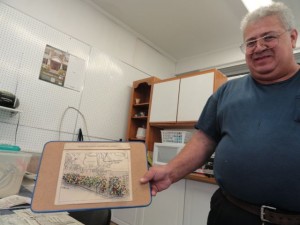By a two-to-one margin in a recent survey, property owners in Ocean City’s Local Historic District said they would opt out of the district, if they could.

The survey led a City Council subcommittee to suggest a smaller district might work better— and that proposal has sparked a larger debate.
The Ocean City Historic Preservation Commission and some homeowners see the Historic District as a final bastion in an onslaught of duplexes. Other owners see a Historic District with a lot more rules and fees than actual history.
The commission is inviting public discussion of the district and proposed changes at a meeting scheduled for 7 p.m. Tuesday, Oct. 7, in Council Chambers on the third floor of City Hall. City Council is working to schedule its own public workshop on the same issues within the next 60 days.
As it considers potential changes, City Council will face the task of balancing the interests of those who want to protect the “Historic District” with those who want to limit the control of the “Hysterical District.”

At issue is a local Historic Preservation Commission that, as a general rule, must approve demolition, new construction or rehabilitation within the district. Property owners must submit applications with associated fees. And they must follow the same rules whether or not their homes are historic.
A 2007 inventory of historically designated properties, for instance, lists 79 of 311 (about 25 percent) properties that are “noncontributing” (not historic). (See document below.)
IT STARTED WITH SOME HOUSEKEEPING
The Commission had proposed a couple of changes to help preserve more historic homes in a slowly dwindling inventory. The changes are designed to make sure owners make a good-faith effort to preserve or sell historic structures before demolishing them and building new.
- The first would change the amount of time a property denied a demolition permit must be marketed for sale from six months to one year.
- The second would require owners to obtain two certified appraisals for the fair market value of the property (as a historic home), and to list the property for sale at the lower price.
The two changes are the most substantial in a proposed ordinance amendment that includes many minor “housekeeping” revisions.

SURVEY SAYS
City Council ultimately must vote twice to pass any ordinance change, and a City Council subcommittee sent out a questionnaire in May to homeowners in the Historic District asking them three questions.
Councilman Mike Allegretto — a member of the subcommittee with Council President Tony Wilson and Councilman Antwan McClellan — said that the questionnaire is a simple attempt to “vet the ideas to the public” before making any decisions.
“It’s just a start in the process,” he said.
- The first question asked about changing the required period for marketing a sale from six months to one year. The results: 25 agreed and 51 did not agree.
- The second asked about change to acquire two appraisals and use the lower of the two. The results: 27 agreed and 52 did not agree.
- The third asked, “Do you believe that a property owner should have the option to opt in or opt out of the Historic District regulations? The results: 54 replied yes and 22 replied no.
Allegretto said he thought about 400 surveys were mailed. With fewer than 80 returned, it remains unclear where the “silent majority” falls on the proposals.

Allegretto said he understands that an opt-out option is not viable for the district.
“But it tells me they’re not happy with it,” he said. “Now what can we do to improve it?”
HISTORIC DISTRICT HISTORY
Ocean City’s first homes and buildings took shape around the prayer meeting area of the Christian resort founded in 1879 — the site now occupied by the Ocean City Tabernacle.
The Historic Preservation Commission was formed in the late 1980s and originally proposed a historic district that extended from North Street to 18th Street between West Avenue and the beach block — a massive area encompassing everything new, old and in-between at the heart of the island.
In January 1993, Ocean City gave final approval to the formation of a district about 15 percent the size of the originally proposed area. The approved Historic District surrounds the Tabernacle in an area roughly from Third Street to Eighth Street between Central and Ocean avenues. The district also includes the 800 block of Wesley Avenue. In an extension that some opponents at the time called “spot zoning,” the historic Life Saving Station at Fourth Street and Atlantic Avenue was added at the recommendation of the Planning Board.
The original ordinance included a “sunset clause” that said the Historic District legislation would “automatically expire and be of no effect on Jan. 1, 1997, unless re-enacted by the City Council.”
The sunset clause was removed by an ordinance amendment passed in June 1995.
An expert survey of historic properties in 2003 led to the creation of the state and nationally registered historic districts in 2003. The properties that made the cut represent a district that is smaller than the local Ocean City Historic District.
A SMALLER LOCAL DISTRICT?
The council subcommittee met with Historic Preservation Commission Chairman John Ball and Vice Chairman Jeff Sutherland last month to discuss the proposed changes.
They talked about a compromise on the first proposed change: requiring six months of “marketing” with two required to be in the summer. (The Commission’s main intent in suggesting the change was to have some summer exposure, since “marketing” requires only a for-sale sign to be placed on the property.)
They talked about further clarifying the proposed change requiring two appraisals (Is the lower of the two figures the list price? Or the final sale price?).
But the council members surprised Ball and Sutherland when they came up with a map that showed a Historic District that was dramatically reduced in size. The council members asked them to take a look and give them some feedback before a meeting with the full Historic Preservation Commission.
“Jeff and I both told them that it wasn’t going to go over well,” Ball said.
And it didn’t.
At a Sept. 9 meeting of the full commission, members reacted passionately to the proposal — saying that starting to carve into the district would be tantamount to eating the whole thing.
“It wasn’t pretty,” Ball said. “I knew how they were going to react.”
But Ball said media reports on the meeting were “blown out of proportion.” He said it was a discussion and that council received unequivocal feedback.
“To me, the ball’s in their court,” he said. “Now that they’ve gotten the reaction of the commission. There’s nothing adversarial here.”
“The meetings between the committee and Historic Preservation Commission were very productive and will likely end up being satisfactory,” Sutherland said. “I admire the fact that they’re actually trying to do something.”
THE HYSTERICAL DISTRICT
Because it was intended only as a discussion starter, the council subcommittee will not make a copy of the proposed new Historic District map public.
Allegretto said it did not touch the state or federal districts and eliminated some of the areas on the periphery.
That would likely include the 300 block of Ocean Avenue, where Mark Crego has lived since before the Historic District was created.
He describes his home as something built in 1927 and later converted to a triplex (which he uses as a single-family home). His back yard is home to a 19th-century cottage.
“It’s just an old house,” he said.
His block did not make it onto the state or national historic registers and includes the four-story Ocean Court co-op.
Crego said it’s easy for people in other parts of the city, state or country to be in favor of an Ocean City historic district. It sounds good. But if he wants to rebuild or rehabilitate his 87-year-old house, he’s at the mercy of the Ocean City Historic Preservation Commission.
Crego was denied a demolition permit in 2000. At the time, he started a petition drive to eliminate the district. He’s the author of a Facebook page titled “Hysterical District.”
“There are absolutely no benefits” unless you own a bed-and-breakfast (eligible for tax breaks), Crego said.
He said the district was started and the “sunset clause” eliminated without widespread support from property owners.
“We have lives,” he said of notifications that did or didn’t go out and participation in the public process.
Crego remains a voice for what he says are the majority of property owners within the district who oppose it.
“If 51 percent of the people wanted the district, I’d go with it,” he said.
PUBLIC INPUT
Ball said there are no applications or regular business on the agenda for Tuesday’s Historic Preservation Commission meeting (7 p.m. Oct. 7 at City Hall).
“I’m going to open it up to public discussion,” he said.
He’s encouraging feedback on the proposed changes.
Allegretto had hoped to schedule a City Council workshop on the topic for Nov. 6. But that date may conflict with a capital budget workshop.
The date will be announced and be within the next two months, he said.
__________
Sign up for OCNJ Daily’s free newsletter and breaking news alerts
“Like” us on Facebook





